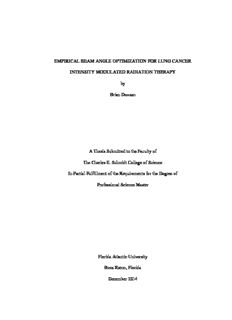
Empirical beam angle optimization for lung cancer intensity modulated radiation therapy PDF
Preview Empirical beam angle optimization for lung cancer intensity modulated radiation therapy
EMPIRICAL BEAM ANGLE OPTIMIZATION FOR LUNG CANCER INTENSITY MODULATED RADIATION THERAPY by Brian Doozan A Thesis Submitted to the Faculty of The Charles E. Schmidt College of Science In Partial Fulfillment of the Requirements for the Degree of Professional Science Master Florida Atlantic University Boca Raton, Florida December 2014 Copyright 2014 by Brian Doozan ii ABSTRACT Author: Brian Doozan Title: Empirical Beam Angle Optimization for Lung Cancer Intensity Modulated Radiation Therapy Institution: Florida Atlantic University Thesis Advisor: Silvia Pella, Ph.D., DABR Degree: Professional Science Master Year: 2014 Empirical methods of beam angle optimization (BAO) are tested against the BAO that is currently employed in Eclipse treatment planning software. Creating an improved BAO can decrease the amount of time a dosimetrist spends on making a treatment plan, improve the treatment quality and enhance the tools an inexperienced dosimetrist can use to develop planning techniques. Using empirical data created by experienced dosimetrists from 69 patients treated for lung cancer, the most frequently used gantry angles were applied to four different regions in each lung to gather an optimal set of fields that could be used to treat future lung cancer patients. This method, given the moniker FAU BAO, is compared in 7 plans created with the Eclipse BAO choosing 5 fields and 9 fields. The results show that the conformality index improved by 30% or 3% when using the 5 and 9 fields. The conformation number was better by 12% from the 5 fields and 9% from the 9 iv fields. The organs at risk (OAR) were overall more protected to produce fewer nonstochastic effects from the radiation treatment with the FAU BAO. v ACKNOWLEGEMENTS This research would not be possible without the help and support of the people at Florida Atlantic University (FAU) as well as those who work at South Florida Radiation Oncology (SFRO). Without the guidance of my Thesis Advisor, Dr. Silvia Pella, Ph.D., DABR of SFRO, I would not have accomplished this and many other projects. She allowed me to be able to explore the field of Medical Physics and was always available to any student who was willing to take the time to learn. I am truly grateful for her guidance and mentorship. I would also like to personally acknowledge my Thesis Co-Advisor, Dr. Th. Leventouri, Ph.D. Professor of Physics and Director of the Medical Physics program. She is the heart of the Medical Physics program at FAU and without her extensive efforts to build the program; none of this would have been possible. She has a door that is always open and has assisted in solving any problem that was given to me. The other medical physicists that have made this possible that I would like to thank include Charles Shang, MS, DABR of the Lynn Cancer Institute, Boca Raton Regional Hospital and Zoubir Ouhib, MS, DABR of the same institution. They are great mentors and have a wealth of knowledge and experience that they are generous enough to share. The time that they give to help with the program greatly enhanced the ability for me to gather the resources that I need to be a successful medical physicist. vi I would like to thank Angelina Bacala, Ph.D., for her help in gathering and sorting data. She was a great asset as were the rest of my classmates. Finally, I would like to thank Thomas Costantino, SFRO, for his expertise in dosimetry. His insight on difficult planning techniques and help in modifying my own plans served as a turning point in my career and I am eternally appreciative for his willingness to donate his time and experience. vii EMPIRICAL BEAM ANGLE OPTIMIZATION FOR LUNG CANCER INTENSITY MODULATED RADIATION THERAPY LIST OF TABLES ........................................................................................................ xi LIST OF FIGURES ...................................................................................................... xii 1. INTRODUCTION .......................................................................................................1 1.1 Purpose ..................................................................................................................1 1.2 Lung Cancer ...........................................................................................................1 1.3 Radiation Treatment ...............................................................................................2 1.4 Linear Quadratic Model .........................................................................................3 1.5 Fractionation ..........................................................................................................5 1.6 External Beam Radiation Therapy ..........................................................................6 1.7 A Brief History of Radiation Treatment ..................................................................8 1.7.2 Lung Cancer Treatment ...................................................................................9 1.8 Algorithms Used in Planning ................................................................................ 13 1.9 Objective function ................................................................................................ 16 1.10 Normal Tissue Complication and Tumor Control Probabilities ........................... 18 1.11 Modeling Challenges .......................................................................................... 20 1.12 Calculating Dose ................................................................................................ 21 viii 1.13 Inhomogeneity correction ................................................................................... 24 1.14 Normalization Factor .......................................................................................... 27 1.15 Evaluation of a Plan ........................................................................................... 28 1.16 An Introduction of an Empirical Method of Beam Angle Optimization............... 30 2. MATERIALS AND METHODS ............................................................................... 32 2.1 Equipment for Treatment...................................................................................... 32 2.2 Selection of Patient’s Data Meeting the Study Criteria ......................................... 32 2.3 Defining Tumor Location ..................................................................................... 33 3. RESULTS AND DISCUSSION................................................................................. 40 3.1 Patient Data Study ................................................................................................ 40 3.2 Most Frequent Gantry Angles ............................................................................... 41 3.2.1 Medial Positions ............................................................................................ 41 3.2.2 Central Lateral Positions ................................................................................ 44 3.2.3 Lateral Inferior Positions................................................................................ 46 3.2.4 Lateral Superior Positions .............................................................................. 48 3.3 Plans Made With Eclipse BAO............................................................................. 51 3.4 Dose Distribution ................................................................................................. 52 3.5 Isodose Volume Comparison ................................................................................ 55 3.6 Maximum Dose Points ......................................................................................... 58 3.7 Conformality Index and Conformation Number.................................................... 59 ix 3.8 Organs at Risk ...................................................................................................... 62 3.9 Dose Volume Histogram ...................................................................................... 66 3.10 Monitor Unit Comparison................................................................................... 70 3.11 Nine Beam Comparison...................................................................................... 71 4. CONCLUSION ......................................................................................................... 75 REFERENCES .............................................................................................................. 77 x
Description: